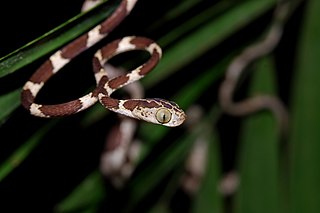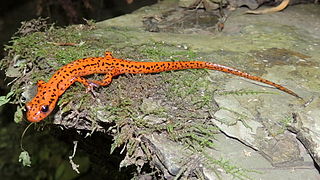
Salamanders are a group of amphibians typically characterized by a lizard-like appearance, with slender bodies, blunt snouts, short limbs projecting at right angles to the body, and the presence of a tail in both larvae and adults. All present-day salamander families are grouped together under the order Urodela. Salamander diversity is most abundant in the Northern Hemisphere and most species are found in the Holarctic ecozone, with some species present in the Neotropical zone.

Imantodes cenchoa is a species of rear-fanged colubrid snake distributed in Mexico, Central America, and South America.

The arboreal salamander is a species of climbing salamander. An insectivore, it is native to California and Baja California, where it is primarily associated with oak and sycamore woodlands, and thick chaparral.

Bolitoglossa is a genus of lungless salamanders, also called mushroom-tongued salamanders, tropical climbing salamanders, or web-footed salamanders, in the family Plethodontidae. Their range is between northern Mexico through Central America to Colombia, Venezuela, Ecuador, Peru, northeastern Brazil, and central Bolivia. Neotropical salamanders of the Bolitoglossa make up the largest genus in the order Caudata, consisting of approximately one-fifth of all known species of salamanders. Adult salamanders range anywhere from 45mm to 200mm in length depending on their specific species. They are notorious for their ability to project their tongue at prey items, as indicated from their name. They are also known for their webbed feet, having significantly more webbing than any other species outside their genus with the exception of the cave-dwelling Mexican bolitoglossine Chiropterotriton magnipes. Although webbed feet are a common characteristic of these salamanders, only about half of the species in this genus contain webbed feet.
Bolitoglossa engelhardti is a species of salamander in the family Plethodontidae. It is found in the extreme south-eastern Chiapas, Mexico, and eastward along the Pacific versant to Volcán Atitlán in south-western Guatemala. It is named for Teodoro Engelhardt, Guatemalan plantation owner who entertained Karl Patterson Schmidt and his expedition. Its common names include Engelhardt's salamander, Engelhardt's mushroomtongue salamander, and Engelhardt's climbing salamander.
The San Gil climbing salamander, also known as the San Gil mushroomtongue salamander, is a species of salamander belonging to the family Plethodontidae. It is endemic to Colombia, and its natural habitats are tropical highly humid forests; it has also been reported from a coffee plantation. The greatest threat posed to this species is habitat loss, however they are currently nowhere near the risk of extinction. The species' name honors Antoine Rouhaire, a French naturalist who collected the species holotype.
Bolitoglossa oresbia is a species of salamander in the family Plethodontidae. It is endemic to Honduras and is known from the summit of Cerro El Zarciadero and the southwestern side of the nearby Cerro Azul Meámbar National Park, in the northern Comayagua Department.

Bolitoglossa pandi is a species of salamander in the family Plethodontidae. It is endemic to the Cundinamarca Department of Colombia and only known from three locations on the western slopes of the Cordillera Oriental, including its type locality, Pandi; it is named after the type locality where it had been collected 50 years before being described as a new species in 1963.

Savage's salamander, also known as Savage's mushroomtongue salamander, is a species of salamander in the family Plethodontidae. It is endemic to the Sierra Nevada de Santa Marta in northern Colombia. The record from Venezuela represents another species, likely Bolitoglossa guaramacalensis. The species is named after Jay M. Savage, an American herpetologist.

The seepage salamander is a small, terrestrial species of salamander in the family Plethodontidae. It is endemic to the United States. They are found in small areas of Tennessee, North Carolina, Georgia, and Alabama. Its natural habitats are temperate forests, intermittent rivers, and freshwater springs. It gets its name from the seepages around which it lives. It is very similar in its appearance and life history to the pygmy salamander. These two species differ greatly from the other Desmognathus species. They are the smallest salamanders in the genus, measuring only 3–5 cm (1–2 in) in length. They are also the only two terrestrial, direct-developing Desmognathus species. However, the two species are not often seen to coexist, differing in distribution by elevation; although there are exceptions. The seepage salamander is currently listed as Near Threatened, with its numbers declining in most of states in which it is found. It is threatened by habitat loss, with logging having a major effect.

Desmognathus fuscus is a species of amphibian in the family Plethodontidae. The species is commonly called the dusky salamander or northern dusky salamander to distinguish it from populations in the southern United States which form a separate species, the southern dusky salamander. The northern dusky salamander is the most widespread representative of its genus in Canada. It can be found in eastern North America from extreme eastern Canada in New Brunswick south into the panhandle of Florida and west to Louisiana. The size of the species' total population is unknown, but is assumed to easily exceed 100,000. The species' habitat differs somewhat geographically; dusky salamanders in the northern part of the range prefer rocky woodland streams, seepages, and springs, while those in the south favor floodplains, sloughs, and muddy places along upland streams. They are most common where water is running or trickling. They hide under various objects, such as leaves or rocks, either in or near water. Alternatively, they may enter burrows for protection. The dusky salamander lays its eggs close to water under moss or rocks, in logs, or in stream-bank cavities. The larval stage which follows is normally aquatic.

The pygmy salamander is a species of salamander in the family Plethodontidae. It is endemic to the United States in the southern Appalachians in North Carolina and Tennessee.

The northern two-lined salamander is a species of salamander in the family Plethodontidae found in Canada and the United States. Its natural habitats are temperate forests, temperate shrubland, rivers, intermittent rivers, freshwater marshes, freshwater springs, arable land, and urban areas. It is more water-oriented than the related northern redback salamander, and can often be found in and around water such as rain puddles, streams, swamps, and damp stream beds, whereas the northern redback tends to be found in damp ground, but usually not near open water.

The Yonahlossee salamander is a particularly large woodland salamander from the southern Appalachian Mountains in the United States. The species is a member of the family Plethodontidae, which is characterized by being lungless and reproductive direct development. P. yonahlossee was first described in 1917 by E.R Dunn on a collection site on Grandfather Mountain in North Carolina. The common and specific name is of Native American origin, meaning “trail of the bear”. It is derived from Yonahlossee Road northeast of Linville, where the specimen was first described.

The red salamander is a species of salamander in the family Plethodontidae endemic to the eastern United States. Its skin is orange/red with random black spots. Its habitats are temperate forests, small creeks, ponds, forests, temperate shrubland, rivers, intermittent rivers, freshwater, trees springs. Overall this species is common and widespread, but locally it has declined because of habitat loss and it is considered threatened in Indiana. Red salamanders eat insects, earthworms, spiders, small crustaceans, snails and smaller salamanders. The red salamander, as a member of the family Plethodontidae, lacks lungs and respires through its skin.

Speleomantes, the European cave salamanders, is a genus of salamanders in the family Plethodontidae, commonly known as the lungless salamanders. It is one of two genera in the family to inhabit the Old World, with the remaining 250 or so species being found in North, Central and South America. This genus is endemic to Italy and a few nearby areas.
Thorius aureus, the golden thorius, is a species of salamander in the genus Thorius, the Mexican pigmy salamanders, part of the lungless salamander family. It is endemic to mountainous areas of north central Oaxaca State in Mexico. It is one of the largest Thorius species.

The spotted-tail salamander, also known as a "cave salamander", is a species of brook salamander.

Sarcohyla miahuatlanensis, or the Sierra Miahuatlan spikethumb frog, is a species of frog in the family Hylidae. It is endemic to Mexico and only known from its type locality near Candelaria Loxicha on the Sierra de Miahuatlán in Oaxaca.















